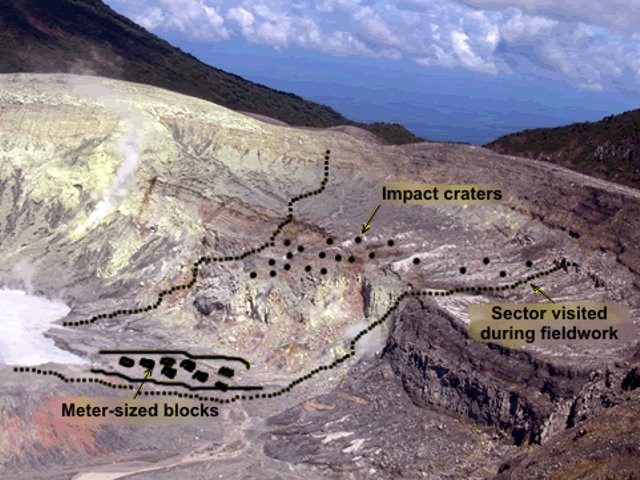Report on Poas (Costa Rica) — March 2006
Bulletin of the Global Volcanism Network, vol. 31, no. 3 (March 2006)
Managing Editor: Richard Wunderman.
Poas (Costa Rica) Small phreatic eruption on 24 March 2006, the first since 1994
Please cite this report as:
Global Volcanism Program, 2006. Report on Poas (Costa Rica) (Wunderman, R., ed.). Bulletin of the Global Volcanism Network, 31:3. Smithsonian Institution. https://doi.org/10.5479/si.GVP.BGVN200603-345040
Poas
Costa Rica
10.2°N, 84.233°W; summit elev. 2697 m
All times are local (unless otherwise noted)
Poás was last reported on in BGVN 28:09, covering the period from September 2001 to December 2002. The focus of activity at Poás during that time was the main crater and its fumaroles, and its low-pH, variably colored lake.
A field team from Observatorio Vulcanológico y Sismológico de Costa Rica, Universidad Nacional (OVSICORI-UNA) visited Poás on 25 January 2006 and found that the level of the volcano's hot acidic crater lake had risen in comparison to the previous month. Sustained rainfall during the previous months caused the water level to rise by ~ 4 m. The area of the lake increased by ~ 20%. Flooding occurred in relatively flat areas to the N, E, and SE. The shoreline extended about 150 m toward the SE. Scattered fumaroles and hot spots at the N base of the lava dome were flooded. Increased steaming was visible from the National Park. The average lake temperature remained at 22°C, with hot spots near the rim reaching up to 80°C. OVSICORI-UNA staff noted that in the past an increase in lake level during a rainy period has been followed by a decrease during the drier months of February to April.
On 24 March 2006 around noon, the first eruptions since 1994 began at Poás. The small, phreatic eruptions originated from the bottom of the volcano's Caliente Lake and dispersed mud, gas, and acid rain toward the S and SW parts of the crater. Witnesses described a sudden emission of water and sediments S of the lake. Roaring was heard in a nearby tourist area and weak earthquakes were felt. The strongest eruption occurred on the night of 24 March, when ejected volcanic material reached 200 m high and acid rain showered park headquarters, located 800 m S of the crater. During 25 March at least 8 eruptions took place. Due to the likelihood of more explosions the local National Emergencies Agency temporarily closed the park.
OVSICORI-UNA staff visited the E side of the volcano on 25 March and confirmed that water, blocks, and sediments from the bottom of the lake had been ejected. Several dozens of impact craters were seen with diameters between 15 and 60 cm, extending E as far as 700 m (figure 80). During 22-27 March, harmonic tremor was recorded. On the 27th, there was a reduction in seismicity and it returned to normal levels. No deformation was measured at the volcano. A news article reported that the area around the volcano was closed to visitors.
Following the eruptions that began on 24 March, seismicity at Poás decreased by 27 March and harmonic tremor that was recorded during the heightened activity ceased.
On 1 April 2006, OVSICORI-UNA staff visited Caliente Lake and its surroundings. During this visit the widening of the lake perimeter was confirmed as well as the emplacement of lake sediments and pre-existent blocks from both the bottom of the lake and its walls. Fracturing of the dome's N wall was also confirmed. The lake temperature was 54°C, with a pH of 0.63. The water was light gray due to the great quantity of suspended sediments. The park surrounding the volcano was reopened on 1 April.
Geological Summary. The broad vegetated edifice of Poás, one of the most active volcanoes of Costa Rica, contains three craters along a N-S line. The frequently visited multi-hued summit crater lakes of the basaltic-to-dacitic volcano are easily accessible by vehicle from the nearby capital city of San José. A N-S-trending fissure cutting the complex stratovolcano extends to the lower N flank, where it has produced the Congo stratovolcano and several lake-filled maars. The southernmost of the two summit crater lakes, Botos, last erupted about 7,500 years ago. The more prominent geothermally heated northern lake, Laguna Caliente, is one of the world's most acidic natural lakes, with a pH of near zero. It has been the site of frequent phreatic and phreatomagmatic eruptions since an eruption was reported in 1828. Eruptions often include geyser-like ejections of crater-lake water.
Information Contacts: Eliecer Duarte Gonzalez, Observatorio Vulcanológico y Sismológico de Costa Rica, Universidad Nacional (OVSICORI-UNA), Apartado 86-3000, Heredia, Costa Rica. (URL: http://www.ovsicori.una.ac.cr/); Rafael Barquero, Red Sismiológica Nacional, Sección de Sismología, Vulcanología y Exploración Geofisica, Escuela Centroamericana de Geología, Universidad de Costa Rica, Aptdo. 560-2300, Curridabat, San José, Costa Rica.


